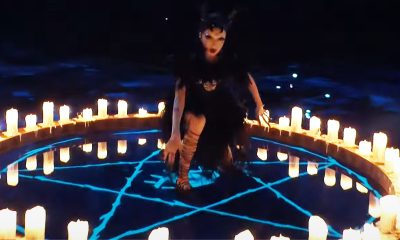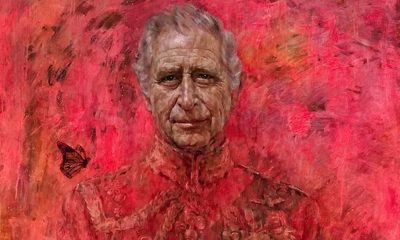Latest News
How a leading American fashion model came to be experimented upon by the CIA mind control team

This Fortean Times article from 2001 describes the infamous case of Candy Jones, a fashion model who became a MKULTRA victim. It is one of the the most documented case of the fashion world mixing with mind control.
How a leading American fashion model came to be experimented upon by the CIA mind control team
To the world she was one of the most successful American fashion models of the 1940s – but she led a secret life as a Manchurian Candidate-style agent for the US intelligence services during the Cold War. Colin Bennett analyses this tale of multiple personality, conspiracy, hypnotic mind-control and fantasy life. Additional research by Bob Rickard.
On 31 December 1972, in the lavish apartment suite of a New York lawyer friend, the well-known 61-year-old radio presenter Long John Nebel married Candy Jones, 47, an internationally famous fashion model. The guests on this happy occasion certainly had plenty of things to talk about. The five men who broke into the Democratic National Committee Headquarters at the Watergate office building in Washington DC the previous summer were facing charges of burglary, conspiracy and wire-tapping. Already, there were rumours that this affair might go all the way to the White House. Though the guests were no doubt happy, the Vietnam campaign still had two years to run, and almost all Americans knew what the result was going to be.
Nebel was the Art Bell of his day, and his all-night radio show had an audience of several millions, but that night, his mind was not on Watergate or Vietnam. He had just married a woman whose face had graced the covers of 11 major national magazines in a single month in 1943. During the Pacific campaign in World War II, photos of Candy in a white polka-dot bathing suit adorned the interiors of ships, tanks, and foxholes.
It had been a lightning courtship – barely 28 days – so Nebel did not know his wife all that well. During the reception, he noticed a curious change come over her; within a very short time, she lost all her natural charm and exuberance. Her voice changed to that of another woman entirely and her normally fluid posture stiffened. Dining in the Ho Ho Chinese restaurant later that evening, Nebel noticed the transformation again; it was as if she were uncomfortable with the Chinese decor, wall-mirrors and candles.
While preparing for bed, Candy began speaking again in the voice Nebel had heard earlier. Even more alarming, this strange personality within Candy had a completely different attitude towards him; ‘she’ sounded cruel, mocking and cold. When Nebel asked her about it, Candy was astonished; she hadn’t noticed the emergence of another voice or personality.
However, a few weeks after their marriage, she did tell Nebel that she had worked for the FBI for some time, adding mysteriously that she might have to go out of town on occasion without giving a reason. This left Nebel wondering whether there was a connection between the ‘other’ personality within Candy and the strange trips she said she made for the FBI.
Candy was born Jessica Wilcox in Atlantic City, New Jersey, in 1925. She grew into a striking blonde, some six feet four inches (1.93m) in height. Her classic American ice-queen face was fashionable before the more accessible faces of Grace Kelly, Jayne Mansfield and Marilyn Monroe came about. Though she was brought up in a fairly affluent environment, her father and her manic depressive mother physically, if not sexually, abused her. (1) Once, her divorced father, on a home visit, crushed her fingers in a nutmeg grater, and her vicious mother beat her on the legs so badly that Candy had to wear thick stockings to conceal the welts. She was not allowed to associate with other children and was often shut in darkened rooms by her mother. It was within such rooms that the very young, panic-stricken Candy developed a family of fantasy figures to keep her company.
In her prison gloom, she visualised these characters appearing in the twilight reflections of a large wall mirror. The name of one of these magical friends was Arlene, and she was to figure crucially in Candy’s later life. Unlike the other figures of this imagined world, Arlene didn’t fade away with Candy’s childhood. As a secondary personality, she grew up and matured with Candy. Arlene’s personality was a sort of mirror-reverse of Candy’s. She had some of the characteristics of Candy’s mother: she was tough and ruthless, sarcastic and cruel, with a grating low voice, quite different from Candy’s own.
This was the voice that Nebel first heard on his wedding day. When she was herself, Candy was the most loving, sociable and charming of women; when she was Arlene, she could become dangerously vicious, even attempting one night to strangle her new husband in a professional military-style manner. Nebel concluded, not unreasonably, that the mind of his new wife had been grossly interfered with. Candy seemed to be mortally afraid of anything Chinese; she was also afraid of doctors, psychiatrists and dentists, all of whom used drugs of one sort or another. Drugs were what Candy was afraid of above all things; whenever drugs were mentioned, in any respect, Candy’s ‘protector’ Arlene would appear, to vehemently deny that such things should ever enter “her” (Candy’s) body.
Nebel discovered that the changes within Candy had a long history and their trail led right into the heart of an organisation that many of his telephone callers had been talking about for years: the Central Intelligence Agency of the United States of America. Nebel then took a grave risk: for many years, he had been an amateur hypnotist, and he decided to put Candy in a light trance, ask a few simple questions, and tape the results. There begins one of the most amazing tales of our time, as told in Donald Bain’s book, The Control of Candy Jones.
While touring military bases in 1945, Candy fell sick in the Philippines and was admitted to hospital in Leyte Gulf. There she met a Dr Gilbert Jensen (2), a young medical officer who gave her vitamin injections which probably saved her life, or at least her looks. Jensen left her his card and said he hoped she would write to him. Many years after this event she was to meet Jensen again, with almost disastrous consequences.
In 1946, she entered a rather loveless marriage to the tricky (and bisexual) fashion czar Harry Conover, who was jailed eventually for fraud. (3) The marriage ended in divorce, in 1959, leaving her with custody of her three sons and her own fashion business with an office in New York. Some time in 1960, an old acquaintance, a retired army general, dropped into this office and, in the cause of casual conversation, asked Candy if she would allow the FBI to use her office as a mail drop. She assented, and also agreed to deliver mail for the FBI when travelling on business because, at the time, she thought of this arrangement as a simple patriotic activity. She had no idea what she was getting into.
One of her first tasks for this (unnamed) general was to deliver a letter to a man in San Francisco while she was on business there. The man was Dr Gilbert Jensen, whom she vaguely remembered. She had dinner with Jensen in San Francisco on 16 November 1960, a day which was to affect the rest of her life. Jensen said that he now worked for the CIA and had an office in Oakland, across Bay Bridge. He said that if Candy wanted to, she could get far deeper into the covert Intelligence business, adding that it could prove lucrative for her. With three sons at private schools, Candy was short of cash and accepted.
The first thing Jensen did was to hypnotise Candy. In doing so, he found Arlene and developed her, using hypnotic techniques and intravenous injections of highly experimental drugs. He succeeded in bringing Arlene forward in Candy’s mind so that she could take Candy over almost completely. This done, he was able to send Candy (with Arlene’s voice and manner) on various experimental missions at home and abroad. Candy would change into Arlene in appearance too, wearing a wig and using a different make-up style. Jensen aimed to create a ‘perfect messenger’, one who could not reveal – even under torture – anything about the message she carried, where she came from or who had sent her.
This operation was vast and highly organised. Candy – as Arlene, the virtual zombie – visited training camps, military bases and secret medical facilities all over America. She was studied and trained in every aspect of covert action, including explosives, close combat with improvised weaponry, disguise and communications. She was taught how to kill with her bare hands, conditioned to resist pain, and shown how to counter interrogation techniques. She was shown off by a proud Jensen to the military on many occasions as an example of narco-hypnotic success: the perfect warrior. Jensen’s pièce de résistance was to demonstrate that his conditioning was so deep that Arlene would kill herself on command. An idea of the kind of moral values of the people involved here is illustrated by Jensen putting a lighted candle inside Candy’s open vagina without her registering pain or fear. He demonstrated this before 24 doctors in an auditorium at the CIA headquarters in Langley, Virginia.
Candy, as Arlene, was sent to Taiwan at least twice on test missions, delivering envelopes. There, she was tortured with electric prods to see if she would crack; she did not. Deeply perverted sexuality appears to have been an implicit element in the covert agenda. In episodes which are disturbing to read, she was frequently stripped, put to bed, drugged, hypnotised and tortured by various parties, including Native Americans on American soil. She was put onto medical examination tables, suffered Gestapo-like interrogations, and was sexually toyed with by women against her will. Sexual approaches were made under hypnosis by Jensen himself, but Candy appears to have fought him off.
Of course none of this was about fighting communism. It was more an example of what Churchill called “perverted science” operating in an old-style Intelligence regime. The hypnotising of Candy was a gimmick-structure like the ‘spin’ put on the American tactical and strategic failure in Vietnam: the infamous body-count, the village ‘pacification’ programme, the useless saturation bombing, and the use of defoliants. The Americans would have been better giving the Vietnamese free Japanese television sets and putting them to sleep the easy way. But perhaps we are dealing here with something more sinister than a failed Cold War weapons system. The system might have failed against the Communists, but did it fail when it turned its head against the American State itself? Mark Chapman, Sirhan Sirhan, John Hinckley, James Earl Ray, and Lee Harvey Oswald are said to be evidence that there were other ‘Jensens’ at work in America.
Jensen knew he was taking terrible risks; he could not be sure whether Arlene wouldn’t put in an unplanned appearance at any time in Candy’s everyday life. Despite his precautions, this, of course, happened, otherwise nothing would be known of her experiences; Candy had no idea that she had been elsewhere or had done anything different from her normal round, apart from her visits to Jensen and to deliver mail. That was all she knew; the rest was a blank. After her adventures and tests were over, Jensen took her out of trance, and her conscious life became a seamless robe once more.
We only know this story from the audio tapes of Candy speaking under hypnosis and being questioned by Nebel. When Candy herself heard these tapes, she could not believe that she herself had undergone the experiences that Arlene described. From many tapes over a number of years, author Donald Bain skilfully constructed a complex four-character play between Arlene and Nebel, Jensen and Candy. Arlene is an abstraction in the head of Candy; Nebel is substance and Jensen is a shadow-figure. This drama was heightened by increasing external evidence that Jensen did indeed exist and was certainly engaged in the kind of activity Candy described. By the mid-70s, Nebel had terminal cancer and, distraught over Candy’s terrible victimisation and the suspicion that Candy had secretly seen Jensen several times since their marriage, thought of exacting revenge. He told Bain that he was going to kill Jensen, but Bain managed to dissuade him.
As a prototype for later books such as Cathy O’Brien’s Trance Formation of America and Annie McKenna’s Paperclip Dolls, Bain’s book is a brilliant achievement. Scorning a popular commercial framework, he spent a considerable amount of time extracting Candy Jones’s story from hundreds of cassette tapes. His approach was to juxtapose the abstract world in Candy’s head against John Nebel’s deepening questions, cross-referenced by the shadow-figure of Jensen. The tale went back over many years, but lacked the voice of Jensen himself; information about him and his intentions had to be reconstructed from one side of the dialogue only. Although he was only a shadow persona, Nebel was convinced that there was enough external evidence to show that he was more substantial than Arlene.
A more difficult problem was the removal of the many blocks placed, like layers of ancient brickwork, inside Candy’s mind by Jensen. Nebel tried posing as Jensen when questioning the entranced Candy; however, Arlene often noticed this tactic and warned Nebel that she knew he was tricking Candy. Arlene herself liked Jensen, whereas Candy did not. Nebel fared better when he pretended to be her alter ego, Arlene. Candy was far more comfortable talking to ‘herself’ in this way and, revealed much information about Jensen’s activities.
Donald Bain suggests that Candy, as Arlene, carried out many more experimental missions for Jensen than ever were discovered. He checked out her office attendance hours throughout the 1960s with her business manager. Over a period of 10 years, she was frequently absent under the cover of business trips on which it appeared no business was done. Fragments of these trips emerged under hypnosis, such as one occasion when she said that she carried a gun for Jensen.
Bain ends his book with a cliffhanger. Despite finally accepting treatment from straight doctors, Candy misses her Jensen fix, and becomes a secret junkie for her Arlene transformations. She tries to hide her attempts to contact Jensen and the CIA from Nebel. But what worried Nebel more, before he died, were the attempts by the CIA and Jensen to contact Candy. Her adventures apparently took place between 1960 and 1971, but Bain declared that he could not be quite sure they had ended.
The courageous Nebel (right, with George Adamski) died of cancer soon after Bain’s book was published, still without the answers he sought about his wife’s secret life. He drew some consolation from the fact that, for a brief historical moment, he had torn the mask off the hidden controllers of America. In a similar way to other glamorous figures, Candy Jones entered unwittingly into that mysterium of power which forever belies the conscious social-democratic view of nature and society. If Jane Mansfield fell prey to the forces of schlock consumerism, and Marilyn Monroe was a victim of high State intrigue, Candy Jones was certainly a casualty of the interface of the American Intelligence and ultra-right medical/psychiatric establishments. Both these national sectors were a vital part of the burgeoning American military-industrial complex which was flexing its new-found muscles in the 1950s and 1960s. (4)
Even in adult life, such high-profile women as Candy Jones remain fairy children, like the junior mannequin Jon Benet Ramsey, or Sylvia Plath. (5) Candy was chosen, most probably, not only because she was found to be very easily hypnotised (6), but because also she was one of the early prototype media-dolls. America first gave birth to this brood, and all its assassins share similar characteristics. American culture is still the main generator of the controls and designs of the world’s dream-machine, and its consumer products, like television, are doll’s house furniture. As dolls, such characters are more system-animals than human, and all kinds of experimental processes and changes occur within the hinterland of these two states, making the half-trance their natural condition.
It could well be that Jensen was conducting the first experiments in mythological engineering as part of the emerging MKULTRA (7) programme. Candy’s first husband had already made her into a super-doll, something that Jensen could work on. Bain’s conclusion is that Jensen’s work was within and for the Intelligence sector; but Jensen may have had an altogether more sophisticated agenda. If Candy represents the innocent imagination, suspended somewhere between the worlds of Jules Verne and George Adamski, Jensen represents the evil side of science. This is the dark world of Auschwitz which, as we know, was run as a joint-stock company by scientists, doctors, and corporate industrialists.
The artificial creation and manipulation of media-sirens may have been his primary objective. Like Monroe, Candy could therefore have been part of the early-middle development of what the American armed forces now call ‘non-lethal weaponry’. Perhaps Big Brother, like the coal-miner, has become an industrial relic; and perhaps Orwell was wrong and Huxley was right. Limitless cheap pleasure, not pain or suffering, is to be the ultimate weapon used in breaking the will of a population, without a drop of blood being shed.
Donald Bain shows that when sex and glamour are mixed with conspiracy and science (in this case experimental narco-technology), a ‘reality’ is enthroned which begins to look like a cover from the kind of science-fiction magazine both Jensen and Nebel must have read in their youth. On these covers, beautiful female bodies are snared and entangled with wires, consoles and aerials, well-endowed girls in torn blouses run from clanking cyberclones, and lizard-like figures wield hypodermic needles.
Long John Nebel must have wondered, at some point, just how close to such covers his life with Candy had become. For many years, sleepless New Yorkers had heard Nebel’s late-night callers rant about the very things that the entranced Candy described. As soon as Nebel heard the voice of Arlene, he entered the world of trance-state America. It is a world in which exit wounds become entrance wounds, and in which Jack Ruby’s last hours as a free man remain as enigmatic as the last phone calls of Marilyn Monroe… or the mysterious travels of Candy Jones.
- Laser beam able to destroy targets at speed of light is tested from British army vehicle for first time
- New Fountain in Vienna Shows What Ruling Oligarchy Think of Us and Celebrates How They've Warped and Ruined Us
- Cartoon Network 'Mighty Magiswords' creator Kyle Carrozza arrested on child p**n charges
- Biden said this … and then something happened.
- BlackRock linked firm, Austin Private Wealth (APW), shorted Trump stock shortly before shooting.
- They don't even hide anymore …
- Global IT meltdown show perils of cashless society
Get an e-mail notification as soon as a new article is published on The Vigilant Citizen.
-

 Movies and TV2 months ago
Movies and TV2 months agoThe Eurovision 2024 Finale Was Basically a Demonic Ritual
-

 Pics of the Month2 months ago
Pics of the Month2 months agoSymbolic Pics of the Month 05/24
-

 Latest News3 months ago
Latest News3 months agoBeyond Rap Beef: Kendrick Lamar’s Dark Accusations Against Drake (Including Sex Trafficking)
-

 Movies and TV3 months ago
Movies and TV3 months ago“American Horror Story: Delicate” and its Messages About Hollywood’s Occult Underbelly
-

 VC Resources1 month ago
VC Resources1 month agoThe True Meaning of the Inverted Cross and Why Mass Media Lies About It
-

 Latest News3 weeks ago
Latest News3 weeks agoBiden’s Debate Performance Was Shocking Proof That He’s Merely a Puppet. Who Actually Runs the Country?
-

 Latest News2 months ago
Latest News2 months agoBilderberg 2024 or How the Elite Subverts Politics, Technology, Big Pharma and the Media
-

 Movies and TV1 month ago
Movies and TV1 month agoThe Much-Overlooked Symbolism in Roman Polanski’s “The Ninth Gate”



















